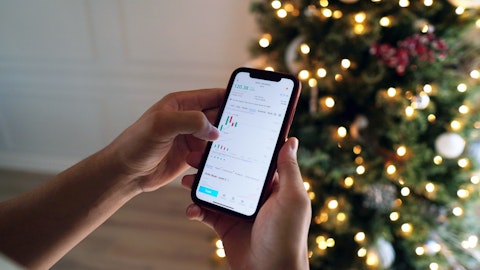Brown & Brown, Inc. (NYSE:BRO) Q4 2022 Earnings Call Transcript January 24, 2023
Operator: Good morning, and welcome to the Brown & Brown Incorporated Fourth Quarter Earnings Conference Call. Today’s call is being recorded. Please note that certain information discussed during this call including information contained in the slide presentation posted in the connection with this call and including answers given in response to your questions may relate to future results and events or otherwise be forward-looking in nature. Such statements reflect our current views with respect to future events, including those relating to the company’s anticipated financial results for the fourth quarter, and are intended to fall within the safe harbor provisions of the securities laws. Actual results or events in the future are subject to a number of risks and uncertainties and may differ materially from those currently anticipated or desired or referenced in any forward-looking statements made as a result of a number of factors.
Such factors include the company’s determination as it finalizes its financial results for the fourth quarter, and its financial results differ from the current preliminary unaudited numbers set forth in the press release issued today — yesterday. Other factors that the company may have currently identified or quantified and those risks and uncertainties identified from time to time in the company’s reports filed with the Securities and Exchange Commission. Additional discussion of these and other factors affecting the company’s business and prospects as well as additional information regarding forward-looking statements is contained in the slide presentation posted in connection with this call and the company’s filings with the Securities and Exchange Commission.
We disclaim any intention or obligation to update or revise any forward-looking statements whether as a result of new information, future events, or otherwise. In addition, there are non-GAAP financial measures used in this conference call. A reconciliation of any non-GAAP financial measures to the most comparable GAAP financial measures can be found in the company’s earnings press release or in the investor presentation for the call on the company’s website at www.bbinsurance.com by clicking on the Investor Relations and then Calendar of Events. With that said, I will now turn the call over to Powell Brown, President, and Chief Executive Officer. You may begin sir.
Powell Brown: Thank you, Norma. Good morning, everyone, and thank you for joining us for our fourth quarter 2022 earnings call. Before we get into the details, I wanted to make a few comments regarding our performance in 2022. The fourth quarter capped off another exceptional year as we delivered strong organic growth while substantially maintaining our margins even with increased variable operating expenses and the financial impact of Hurricane Ian. 2022 was also a milestone for acquisition activity as we significantly increased our international capabilities with the additions of GRP and BdB in the U.K. Our consistently strong results are only made possible through the hard work and dedication of our nearly 15,000 teammates.
Now let’s transition to the results for the quarter, I’m on Slide number 4. We delivered $900 million of revenue growing 22% in total and 7.8% organically. Our adjusted EBITDAC margin increased by nearly 300 basis points to 31.4% for the quarter. Adjusted net income per share was $0.50, growing by 28%. We also completed nine acquisitions during the quarter with annual revenues of approximately $17 million. Overall, we’re pleased with the results for the quarter. I’m on Slide 5. We achieved another milestone this year by delivering over $3.5 billion of revenue, growing 17% in total and 8% organically. Our adjusted EBITDAC margin remained strong for the year at 32.8%. On an adjusted basis, our net income per share increased nearly 7% to $2.28.
Lastly, we had a record year for M&A activity completing 30 acquisitions with approximately $435 million of annual revenue. Our acquisitions both large and small are performing well. As a result of our disciplined strategy to acquire top-quality businesses that fit culturally and make sense financially. We have a proven track record of being able to successfully acquire, integrate, and grow companies of all sizes to join the Brown & Brown team. Later in the presentation, Andy will discuss our financial results in more detail. I’m on Slide 6. Let’s start with the economy. We continue to see the expansion of many businesses that are still hiring albeit at a slower pace than in previous quarters. There’s been a general reduction in the number of open positions that companies are looking to fill.
While interest rates have increased materially over the past year we’re not seeing a broad-based impact on our customers in the economy yet. From an insurance standpoint, certain markets have been and remain in significant turmoil. Pricing for CAT property both commercial and residential was under pressure through the third quarter. Then Ian slammed into Florida. This caused 1/1 reinsurance treaties to be bound at higher attachment points and materially higher rates. As a result, we saw incremental price increases and lower limits being offered for placements in late Q4 of last year and early this year. The placement of CAT property in Q4 last year and January of this year with some of the most difficult placements we’ve experienced in decades with rates increasing 20% to 40% or more.
However, properties of lesser construction quality or that have experienced losses could be much higher and I mean much higher than this range. As a result, we had customers unable to buy or afford full limits and therefore ended up increasing their deductibles or purchasing loss limit in order to manage our cost of insurance. In certain cases, this was not possible as lending institutions or condo associations would not allow lower limits or significantly higher deductibles. Admitted market rate increases were similar to prior quarters and were up 3% to 7% across most lines with the outlier being workers’ compensation rates which remained down 1% to 3%. The placement of professional liability and excess liability remain competitive with rates down 5% to up 5%, with public company D&O rates down 5% to down 20% or more.
Regarding cyber, the story is similar to the last few quarters with rates and deductibles continuing to increase but we did see some slight moderation during the quarter. Late in Q4, there were reforms impacting the legal and regulatory environment for insurance in the State of Florida, which included the elimination of one-way attorney’s fees and assignment of benefits. The establishment of a reinsurance backstop for certain carriers and the requirement of arbitration prior to litigation. These changes should be positive for buyers of insurance, but it will take time. From an M&A standpoint, we’re pleased with the nine transactions we completed. We continue to acquire companies that fit culturally and make sense financially. Specifically, the integration of GRP is going very well and we’re acquiring a number of businesses and the financial performance is in line with our expectations.
From an overall industry perspective, the number of transactions slowed materially compared to previous quarters. Like last quarter, if a business is considered to be a platform or a must-have, the market is still aggressive on pricing. Now I’m on Slide 5. Let’s transition — I’m sorry, Slide 7. Let’s transition and discuss our performance of the four segments. For the quarter, our Retail segment delivered organic growth of 2.7% with good growth experienced in most lines of business. Our organic growth was impacted by the slowdown in specialty lines due to lower auto and RV sales as well as slower growth in a couple of our employee benefits businesses due to an extremely tough comparable versus the fourth quarter in the prior year. Our Retail segment delivered another strong year of organic revenue growth of 6.5%.
We’re very pleased with how our business is positioned and the capabilities we have to serve our customers of any size and believe 2023 should be another good year. Once again, our National Programs segment delivered excellent results, growing 22% organically for the quarter. This performance was driven by good new business and retention across most of our programs, as well as exposure unit expansion and rate increases. The National Programs team is performing at a high level by offering a diverse range of products and delivering best-in-class solutions for our customers driving nearly 16% organic growth for the full year. Our Wholesale Brokerage segment delivered another good quarter, growing 8% organically driven by rate increases and new business even with personal lines, which has been a challenge for most of the year.
Our Wholesale Brokerage segment grew 7.6% organically for 2022 and is well positioned to continue their success into ’23. For the quarter, our Services segment delivered modest organic revenue growth as a result of winning new customers and increased storms claims with this expansion, substantially offset by lower claims for certain businesses. Overall, we feel good about our capabilities and the value we deliver for our customers. Now let me turn it over to Andy to discuss our financial performance in more detail.
Andy Watts: Great. Thank you Powell. Good morning, everybody. We’re over on Slide number 8. Like previous quarters we’ll discuss our GAAP results and then certain non-GAAP financial highlights. For the fourth quarter, we delivered 22.1% total revenue growth, organic revenue growth of 7.8%, and our EBITDAC margin increased by 220 basis points. Our net income grew 43% and diluted net income per share increased by 42% to $0.51. Both were impacted by the change in estimated acquisition earn-out payables, which was a credit of $5.8 million in 2022, and the charge of $19.8 million in the prior year. The effective tax rate decreased to 25.2% for the fourth quarter of this year as compared to 27.8% in the fourth quarter of last year, primarily driven by lower statutory rates for our international businesses and the impact of deductibility for acquisition earn-out payable adjustments.
Our weighted average number of shares was substantially flat compared to the prior year, and our dividends per share for the quarter increased to $11.5 or 11.7% compared to the fourth quarter of 2021. We’re over on Slide number 9. This slide presents our results on an adjusted basis, which excludes the impact of movements in foreign currencies on both revenues and expenses. The net gain or loss on disposals, the one-time acquisition integration costs associated with GRP, Orchid, and BdB, and the change in earn-out payables. We’ve included on Slides 18 through 26, reconciliations to the most comparable GAAP measures. On an adjusted basis, our EBITDAC margin grew by 290 basis points versus the prior year. EBITDAC increased by 34.9% and income before income taxes increased by 22.6%.

Pixabay/Public Domain
This margin expansion was due to another solid quarter of revenue growth, increased contingent incentive commissions, and leveraging our expense base even while having a higher year-over-year variable operating cost. The incremental growth rate of adjusted EBITDAC as compared to adjusted income before income taxes was driven by a higher year-over-year interest cost of $29 million and higher amortization of $7 million with both largely driven by the GRP, Orchid, and BdB acquisitions. Our adjusted net income for the quarter increased by 26.9% and adjusted diluted net income per share was $0.50, increasing 28.2%. We’re on Slide number 10. Our Retail segment delivered adjusted total revenue growth of 19.8% driven primarily by acquisition activity and organic revenue growth of 2.7% for the quarter.
Adjusted EBITDAC grew 25.1%, with our adjusted EBITDAC margin increasing by 120 basis points for the quarter, primarily driven by lower year-over-year performance incentives, but was partially offset by higher variable operating cost. We’re on Slide number 11. Our National Programs segment delivered adjusted total revenue growth of 34.1% driven by organic revenue growth of 21.9%, acquisition activity, and higher contingent commissions. Organic growth was positively impacted by approximately $7 million due to the finalization of a growth bonus for one of our programs, which we do not anticipate recurring in 2023. As it relates to flood claims processing revenues associated with Hurricane Ian, we still expect revenues in the range of $12 million to $15 million.
In the fourth quarter, we recognized approximately $8 million. Our contingent commissions were higher due to premium growth and profitable underwriting in our CAT programs, as well as the loss development for Hurricane Ian being lower than originally expected. Adjusted EBITDAC grew by 53% over the prior year and our adjusted margin increased by 540 basis points to 44.1% primarily due to total revenue growth and leveraging our expense base as well as higher contingent commissions and the previously mentioned growth bonus. We’re on Slide number 12. Our Wholesale Brokerage segment delivered adjusted total revenue growth of 17.1% driven by recent acquisitions, good organic revenue growth of 8.1%, and an increase in contingent commissions. Adjusted EBITDAC increased by 19.9%, with the associated margin growing by 70 basis points, which is primarily impacted by increased contingent commissions and good organic growth, but was partially offset by higher variable operating expenses.
We’re on Slide number 13. Adjusted total revenues and organic revenue growth in our Services segment were substantially in line with the prior year. For the quarter, adjusted EBITDAC increased $1.6 million or 23.9% driven by continued management of our expenses. We’re on Slide number 14. This slide represents our GAAP results for both years. In 2022, we delivered revenues of over $3.5 billion growing 17.1%, and earnings per share of $2.37 growing 14.5%. EBITDAC increased by 14% to approximately $1.2 billion. For the year, our share count was substantially flat and our dividends paid during 2022 increased by 11.3%. We’re on Slide number 15. This slide presents our results for both years on an adjusted basis. Our income before income taxes grew 6.6%, and net income per share was $2.28 growing by 6.5% as compared to total revenue growth of 17.3%.
This difference was driven by higher interest and amortization associated with GRP, Orchid, and BdB. Our adjusted EBITDAC margin remained strong at 32.8% but declined slightly by 40 basis points from the prior year due to higher variable cost. Overall, we are very pleased with the results for 2022. We’re on Slide number 16. It’s part of evaluating the performance for the year and the fact that are captives are newer, we wanted to provide some additional color. We participate in two CAT property captives with the goals to increase capacity, drive additional organic growth, participate in strong underwriting results, like we do with contingent commissions, and deliver good returns on our invested capital. One captive participates on a quota-share basis for certain of our wind and quake programs, and the second participates on an excess of loss or reinsurance layer for a personal lines wind program.
Overall, we are very pleased with the top and bottom-line performance, knowing that certain quarters can have volatility when they’re CAT events. It’s important to keep in mind that performance cannot be evaluated on one quarter but it’s better viewed on a full-year basis. In 2022, we recognized approximately $25 million of incremental revenue with about $5 million driven by the acquisition of Orchid. For 2023, we anticipate revenues of approximately $30 million to $35 million. From a risk standpoint for both captives, we can have up to $13 million of exposure in any one occurrence and $25 million in the aggregate. As we always do, we’ve used a disciplined approach to balance upside potential and downside risk versus deployed capital and believe we have structured the programs well to deliver on our objectives.
Few comments regarding liquidity and cash conversion. For 2022, we delivered cash flow from operations of $881 million. Our ratio of cash flow from operations as a percentage of total revenues was 24.7% as compared to 26.5% last year. This lower ratio is due to the payment of earn-outs as certain acquisitions have overperformed our original expectations, incremental interest expense, and paying higher incentive bonuses to our teammates for their outstanding performance in 2021. Overall we are in a strong cash generation and capital position, finishing the year with $650 million of available cash. We also repaid the remaining outstanding balance of $150 million on our revolver that was drawn in connection with our acquisition of GRP, BdB, and Orchid.
We expect to continue to delever over the coming quarters as we have done in the past post larger deployments of capital. We finished the year in a strong liquidity position. With this capital, the cash we will generate in 2023 as well as capacity on our revolver we are well-positioned to fund continued investments in our company. We have a few comments regarding the outlook for 2023. First, for contingent commissions, we anticipate them to be relatively flat year-over-year, but this will be ultimately driven by loss experience. As it pertains to taxes, we expect our effective tax rate to be in the range of 24% to 25%, a slight increase compared to 2022 due to a higher estimated tax rate in the U.K., the lower year-over-year tax benefit from the vesting of stock grants and limitations on the deductibility of certain compensation benefits.
We anticipate our interest expense will be in the range of $185 million to $195 million. Regarding interest income, we’re seeing some nice improvement and are projecting income of approximately $14 million to $17 million subject to how the Fed changes interest rates. As it relates to amortization expense, we’re projecting approximately $162 million to $166 million. This does not include amortization associated with acquisitions that we may complete during 2023. As it relates to margins, we do not see any major headwinds or tailwinds heading into 2023, that shouldn’t materially impact our margins. With that, let me turn it back over to Powell for closing comments.
Powell Brown: Thanks, Andy, for a great report. As we close out ’22 and look forward to ’23, we have a couple of observations. First, last year was another very successful year for Brown & Brown. We delivered over $3.5 billion of revenues growing 17% had our largest year of acquisitions while expanding our footprint and capabilities in the U.K. market. We invested in technology to help improve the experience for our customers and teammates, grew organically at over 8%, delivered strong margins, again, even with higher variable costs and the impacts of Hurricane Ian, as well as generated over $880 million of cash flow from operations. We’re also in a strong position from a capital standpoint and we’ll continue to invest in our capabilities in order to best serve the needs of our customers.
Regarding the economic outlook of 2023, well, there’s a lot of uncertainty regarding inflation and labor shortages, we expect further economic moderation as the impact of higher interest rates take effect. From an insurance standpoint, we’re anticipating admitted market rate increases to be relatively consistent with last year, we expect CAT property rates to be up 10% to 40% or more for at least the first half of the year, as well as capacity to potentially be constrained. It’s not potentially, it will be constrained as the market needs to fully digest an impact. The impact of Hurricane Ian, as well as other insured losses. In addition, professional liability rates should continue to moderate downward. Regarding recent acquisitions they’re performing well and we are expecting good profitable growth in the coming year.
On an M&A front, we have a good pipeline and we’ll continue our disciplined approach to finding great companies that fit culturally and makes sense financially. In summary, we feel great about our business, the diversity of our capabilities and our ability to help customers with risk management solutions that best fit their needs. Our team of almost 15,000 has good momentum, and we’re looking forward to another strong year. With that let me turn it back over to Norma for the Q&A session.
See also 25 Richest People in the World and 10 Pump and Dump Stocks Hedge Funds Like.
Q&A Session
Follow Brown & Brown Inc. (NYSE:BRO)
Follow Brown & Brown Inc. (NYSE:BRO)
Operator: And our first question comes from Greg Peters with Raymond James. Your line is now open sir.
Greg Peters: Great. Good morning, everyone. I know you don’t like to forecast organic revenue growth, but there are two items, one you called out in your commentary about catastrophe pricing. And secondly, in your retail segment, you talked about some employee benefit headwinds or a difficult comparisons. So, when I think about ’23, Powell and Andy, how will those variables — like the June first renewals on property CAT and what’s going on employee benefits, how will that affect your organic results for this year — this upcoming year?
Powell Brown: Okay. Let’s start with the second part first. Let’s talk about employee benefits. Employee benefits overall performed really well for the year and we’re very pleased with those businesses. And as we said in our prepared remarks, that was actually really only in one or two businesses that had a setback. Having said that, I think that EV will continue to perform well in the system. We don’t give organic guidance on that and we don’t break out lines of business, but from an employee benefits standpoint, feel really good. As it relates to the CAT property pricing, the variable there, Greg, as you know is not as much our — I mean, it is there are certain limitations on ability to present limits in some instances. But it’s more of — in my opinion, it’s more of an affordability issue.
And so, if you think about if you’ve been giving rate increases, let’s just say to yourself on your own personal lines homeowners, if you’ve got an increase of let’s say 10% a year for four or five years in a row and then all of a sudden we came on the fifth year and gave you a 25% increase, there is a — the buyers are tiring of that. And so, having said that, availability of capacity in this market is unlike anything I’ve ever seen, I’ve only been in the insurance industry for 33 years now. So, there’s a lot more to go, but I’ve not ever seen anything like this and we will continue to provide solutions to our customers. But sometimes the example I think we used last time and I would use it again is, if you have an entity, and they’re paying $800,000 for their property and the renewal is a $1.8 million, and they say, what can we buy for $1 million, which can’t buy anymore insurance, we can’t afford it.
So, we’re seeing that more and more, Greg. So, the CAT pricing that is going to — is it more of a wildcard. The other thing that we’re seeing is in the CAT capacity and accessing it in some instances, there is commission pressure downward on some of those placements now. So, a lot of people just think, well, as the rate goes up X, then you’re going to — your commission goes up X if you’re on commission as opposed to a fee and that is true sometimes, but in this case, they might cut your commission one or two points, and so we’re seeing that as well. So that’s a harder one to answer, Greg.
Greg Peters: Okay. I understand that. It’s a moving target, especially in the Southeast. I guess for my second question just pivot, Andy, in your comments you talked about — you gave some guidance, and then on adjusted EBITDAC margins you said no tailwinds or headwinds for ’23. So, maybe you can provide some context about — is that — in terms of laying out expectations for Street, is it one where we just expect margins to be flat year-over-year, or maybe give us some color to help us frame what your comments really mean.
Andy Watts: Sure. Well, I think what we’re trying to say on that one, Greg, is we don’t see any major headwinds or tailwinds going into the year. We do have like most everybody else unknowns around what will happen with inflation and T&E, but we’ll work our way through those pieces. I don’t see any major incremental investments that we’re making in the business that we need to call out externally, we’re always making investments in our business, but we do that each year through everything. We do anticipate that T&E will be up year-over-year, just not to the extent that what we saw ’22 versus 2021 right now. So, and that was really why we gave guidance going into 2022 because that was a big variable, but right now, we’re not seeing anything specifically that would impact the margins in 2023 versus 2022.
Greg Peters: And just a point follow-up on that. When you think about organic for ’23, is there some sort of rule-of-thumb I know some of your peers offer rules from that, if the organic, a certain amount we can expand margins, if organic not, I mean, do you have any sort of metrics that you’re thinking about in terms of organic as its impact on margins?
Powell Brown: No.
Greg Peters: Fair enough. Thanks for your answers.
Andy Watts: All right. Thanks, Greg.
Operator: Thank you. One moment for our next question. And our next question comes from Rob Cox with Goldman Sachs. Your line is now open.
Robert Cox: Hi, thanks for taking my question. Just with respect to Retail, you called out a couple of headwinds. I was wondering, specifically on group benefits if the toughest comp was created by a true-up of exposure expectations in the prior year quarter or more so by a deceleration in growth this quarter.
Andy Watts: No, Robert, maybe the way to think about it, is we had a few businesses last year that just had absolutely outsized performance in the fourth quarter. One of them was a newer business that was starting. So, it was in growth mode. So, that’s what makes the year-over-year comparison in the fourth quarter difficult. But as Powell mentioned in his comments, we feel really good about how our businesses are positioned and how they performed for 2022, don’t read more into that in the fourth quarter there’s no reason to.
Robert Cox: Got it. Thank you. That’s helpful. And maybe just moving onto some of the Florida legislative changes. Any comments on what you think the impact of those might be for Brown & Brown in the near term and then perhaps longer term?
Powell Brown: So, Rob, first of all, we think that based upon everything we see they are positive for the operating environment for risk bearers and for insurance in the State of Florida. I’d like to point out that we anticipate that the trial bar will challenge those. So, I don’t think those go in place easily. So, I don’t know what that means relative to timing and adoption, relative to the marketplace what our governor and the State of Florida is trying to do fundamentally is create; one, viable; two, competitive; three, sustainable marketplace. And the State of Florida is not really want to be so-called in the insurance business. But with this disruption, they will have to be bigger in the insurance business for the next several years.
So, I believe — we believe that this is a multi-year transition to bring the Florida marketplace specifically personal lines in Florida back to that kind of environment. So, it will probably take three to five years to have some additional participation by the State of Florida, i.e., what they’re proposing in this and it may need more going forward. But it is not the intent of the Governor to expand their participation, i.e., as being a state risk bearer. So, it’s hard to tell because you got challenges ahead, you got other things. But what we really want and need in the State of Florida is relatively affordable homeowners’ prices for all-sized homes. With the coverage A home of $200,000 versus one that’s over $1 million, and everything in between.
And so, there’s a lot of disruption across those — all those sizes.





